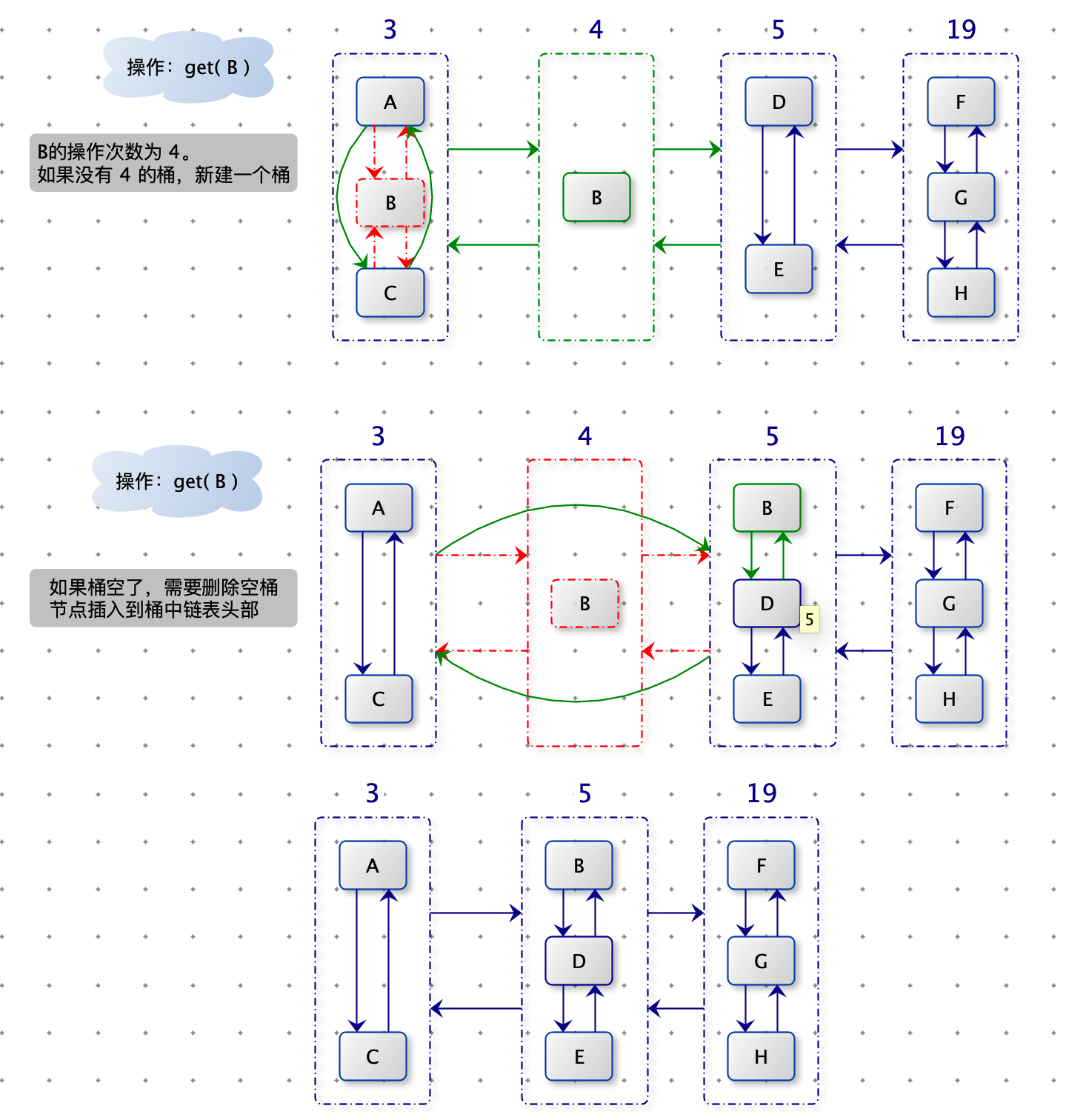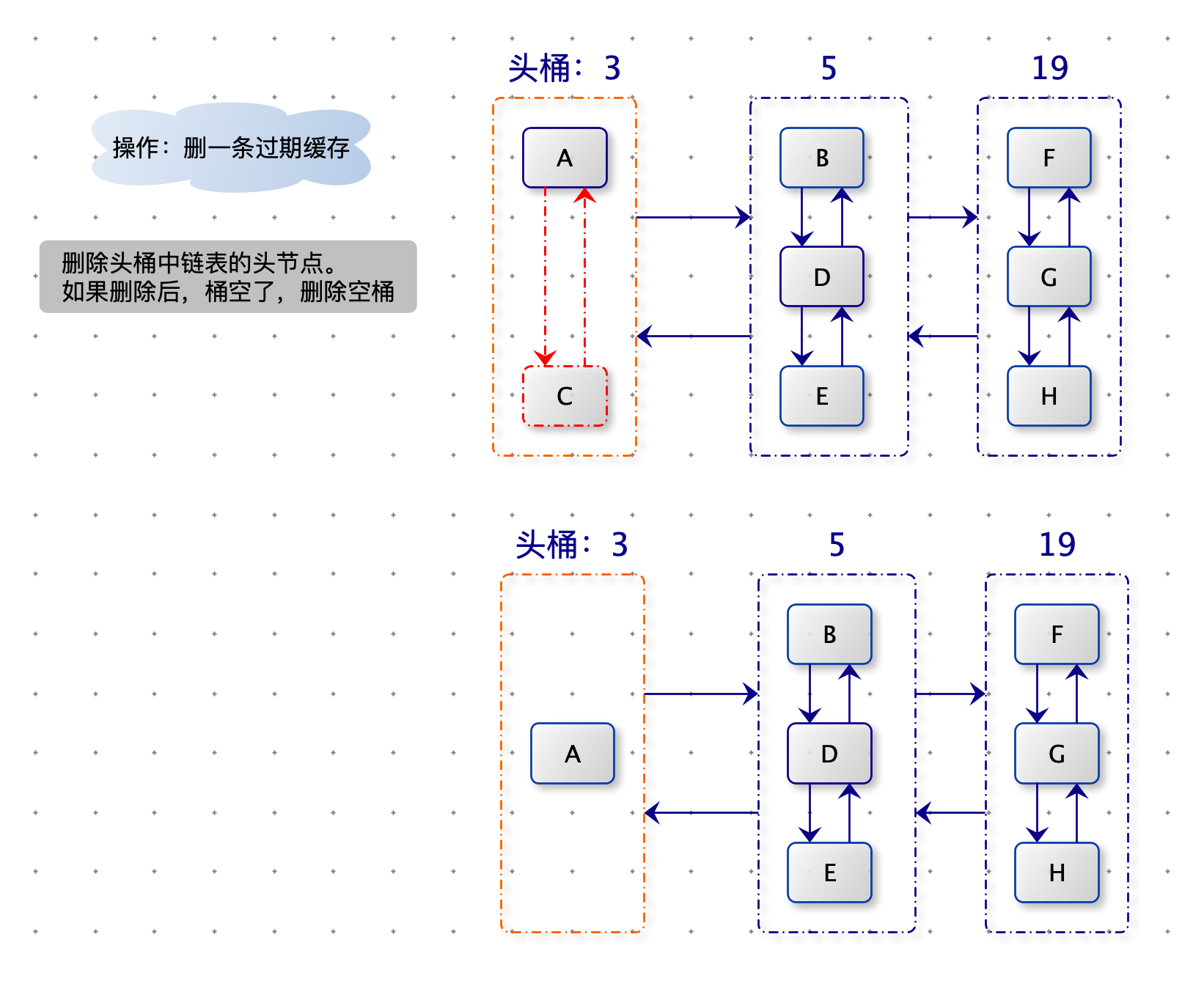一个缓存结构需要实现如下功能:
void set(int key,int value):加入或者修改 key 对应的 value
int get(int key):查询 key 对应的 value 值
但是缓存最多放 K 条记录,如果新的 K + 1 条记录需要加入,就需要根据策略删掉一条记录,然后才能把新记录加入。
这个策略为:在缓存结构的 K 条记录中,哪一个 key 从进入缓存结构的时刻开始,被调用 set 或者 get 次数最少,就删掉这个key 的记录;如果调用次数最少的 key 有多个,上次调用发送最早的 key 被删除。
这个就是 LFU 缓存替换算法。实现这个结构,K 作为参数。
解法一:哈希表 + 有序表
缓存中的数据是 k,v 对,所以用 map 存储数据。由于缓存数据需要根据:使用次数和使用时间进行淘汰,如果遍历数据查找需要淘汰的数据,耗时比较高。因此需要维护一个有序结构,方便查找要淘汰的数据。
- 有序数组:
- 查找要淘汰数据的耗时为:O(1),删除后需要移动数据,耗时为:O(K)
- 每次操作都需要更新 count 和 time 并维护数组的有序,此时也需要查找并移动数据,耗时为为:O(K)
- 有序链表:
- 查找要淘汰数据的耗时为:O(1),(比如头结点或者尾结点)
- 更新操作时,查找对应节点的耗时为:O(K)
- 有序表:
- 查找并移除要淘汰的数据的耗时为:O(log K)
- 更新操作的耗时时为:O(log K)
- 小顶堆:
- 查找并移除要淘汰的数据的耗时为:O(1),移除堆顶后需要堆化的耗时为:O(log K)。
- 更新数据后,也需要堆化,耗时为:O(log K)。
时间复杂度:O(log K)
空间复杂度:O(K)
import java.util.*;
public class LFU1 {
public static class Node implements Comparable<Node> {
public int key;
public int value;
// 这个节点发生get或者set的次数总和
public int count;
// 最后一次操作的时间
public int time;
public Node(int key, int value, int count, int time) {
this.key = key;
this.value = value;
this.count = count;
this.time = time;
}
// 缓存淘汰优先级
// 最少使用(count 越小越容易被淘汰)
// count 相同,时间越早越容易被淘汰(time 越小越容易被淘汰)
@Override
public int compareTo(Node o) {
return count == o.count ? Integer.compare(time, o.time) : Integer.compare(count, o.count);
}
@Override
public String toString() {
return "Node{" + "key=" + key + ", value=" + value + ", count=" + count + ", time=" + time + '}';
}
}
public static class LFUCache {
// 缓存过期优先级
TreeSet<Node> set = new TreeSet<>();
Map<Integer, Node> map = new HashMap<>();
int capacity;
int time = 0; // 用来计算缓存时间
public LFUCache(int capacity) {
this.capacity = Math.max(capacity, 0);
}
public Integer get(int key) {
if (!map.containsKey(key)) {
return null;
}
Node node = map.get(key);
set(key, node.value);
return node.value;
}
public void set(int key, int value) {
this.time += 1;
// 更新
if (map.containsKey(key)) {
Node node = map.get(key);
// 删除再插入(node 的count 和 time 变化了,TreeSet 认为是不同的数据)
set.remove(node);
node.time = this.time;
node.count++;
node.value = value;
set.add(node);
map.put(key, node);
return;
}
// 新增
// 如果内存满了,淘汰一条旧数据
if (this.capacity == this.map.size()) {
remove();
}
Node node = new Node(key, value, 1, this.time);
map.put(key, node);
set.add(node);
}
public void remove() {
if (map.size() == 0) {
return;
}
Node node = set.first();
map.remove(node.key);
set.remove(node);
}
}
}
解法二:哈希表 + 小顶堆
将有序表更换为小顶堆。
删除数据时,heap.pop()
更新数据后,堆化:heap.heapify(node)。更新数据使得 time 和 count 变大,因此只需要从 node 节点开始向下堆化。
时间复杂度:O(log K)
空间复杂度:O(K)
import java.util.*;
public class LFU3 {
public static class Node {
public int key;
public int value;
// 这个节点发生get或者set的次数总和
public int count;
// 最后一次操作的时间
public int time;
public Node(int key, int value, int count, int time) {
this.key = key;
this.value = value;
this.count = count;
this.time = time;
}
@Override
public String toString() {
return "Node{" + "key=" + key + ", value=" + value + ", count=" + count + ", time=" + time + '}';
}
}
public static class NodeComparator implements Comparator<Node> {
// 缓存淘汰优先级
// 最少使用(count 越小越容易被淘汰)
// count 相同,时间越早越容易被淘汰(time 越小越容易被淘汰)
@Override
public int compare(Node o1, Node o2) {
return o1.count == o2.count ? Integer.compare(o1.time, o2.time) : Integer.compare(o1.count, o2.count);
}
}
public static class LFUCache {
// 缓存过期优先级
HeapGreater<Node> heap = new HeapGreater<>(new NodeComparator());
Map<Integer, Node> map = new HashMap<>();
int capacity;
int time = 0; // 用来计算缓存时间
public LFUCache(int capacity) {
this.capacity = Math.max(capacity, 0);
}
public Integer get(int key) {
if (!map.containsKey(key)) {
return null;
}
Node node = map.get(key);
set(key, node.value);
return node.value;
}
public void set(int key, int value) {
this.time += 1;
// 更新
if (map.containsKey(key)) {
Node node = map.get(key);
// 删除再插入(node 的count 和 time 变化了,TreeSet 认为是不同的数据)
node.time = this.time;
node.count++;
node.value = value;
heap.heapify(node);
map.put(key, node);
return;
}
// 新增
// 如果内存慢了,淘汰一条旧数据
if (this.capacity == this.map.size()) {
remove();
}
Node node = new Node(key, value, 1, this.time);
map.put(key, node);
heap.push(node);
}
public void remove() {
if (map.size() == 0) {
return;
}
Node node = heap.pop();
map.remove(node.key);
}
}
}
加强堆的部分代码
import java.util.*;
public class HeapGreater<T> {
private ArrayList<T> heap;
private HashMap<T, Integer> indexMap;
private int heapSize;
private Comparator<? super T> comp;
public HeapGreater(Comparator<? super T> c) {
heap = new ArrayList<>();
indexMap = new HashMap<>();
heapSize = 0;
comp = c;
}
public void push(T obj) {
heap.add(obj);
indexMap.put(obj, heapSize);
heapInsert(heapSize++);
}
public T pop() {
T ans = heap.get(0);
swap(0, heapSize - 1);
indexMap.remove(ans);
heap.remove(--heapSize);
heapify(0);
return ans;
}
private void heapInsert(int index) {
while (comp.compare(heap.get(index), heap.get((index - 1) / 2)) < 0) {
swap(index, (index - 1) / 2);
index = (index - 1) / 2;
}
}
public void heapify(T obj) {
heapify(indexMap.get(obj));
}
private void heapify(int index) {
int left = index * 2 + 1;
while (left < heapSize) {
int best = left + 1 < heapSize && comp.compare(heap.get(left + 1), heap.get(left)) < 0 ? (left + 1) : left;
best = comp.compare(heap.get(best), heap.get(index)) < 0 ? best : index;
if (best == index) {
break;
}
swap(best, index);
index = best;
left = index * 2 + 1;
}
}
private void swap(int i, int j) {
T o1 = heap.get(i);
T o2 = heap.get(j);
heap.set(i, o2);
heap.set(j, o1);
indexMap.put(o2, i);
indexMap.put(o1, j);
}
}
解法三:哈希表 + 二维双向链表
如下图就是一个二维双向链表。桶与桶之间是双向链表,桶内有一个双向链表。桶内双向链表上的数据拥有相同的操作次数,越靠近头部的数据,操作时间越近(从链表头部插入新数据,那么要过期数据从尾部移除)。所以要过期一个数据,删除操作数最小的桶(头桶)中链表的尾节点。

下图演示了桶之间链表和桶内链表的变化过程。
**原则:缺少操作数的桶,就新建桶。节点移走后出现空桶,将空桶删除。注意在这个过程中保持:桶之间的双向链表正确连接。**调用 get(B) :B 的count 从 3 变为 4,没有操作数为 4 的桶,就新建桶,将新桶插入在桶 3 和 桶 5 之间。将节点 B 从桶 3 中移除,插入桶 4 中。
再次调用 get(B):B 的 count 从 4 变为 5,有操作数为 5 的桶,将节点 B 从桶 4 中移除,插入桶 5 (注意是头节点)中。桶 4 移除节点 B 后,成为空桶,删除空桶。将桶 3 与 桶 5 直接连接。

当需要删除一条过期数据时,我们需要在头桶中,删除桶内链表的尾节点(尾结点是最早操作的数据)。

时间复杂度:O(1)
空间复杂度:O(K)
import java.util.*;
public class LFU2 {
public static class Node {
public int key;
public int value;
// 这个节点发生get或者set的次数总和
public int count;
// 双向链表上一个节点
public Node up;
// 双向链表下一个节点
public Node down;
public Node(int key, int value, int count) {
this.key = key;
this.value = value;
this.count = count;
}
@Override
public String toString() {
return "Node{" + "key=" + key + ", value=" + value + ", count=" + count + '}';
}
}
public static class NodeList {
// 桶内链表的头节点
public Node head;
// 桶内链表的尾节点
public Node tail;
// 桶之间的前一个桶
public NodeList last;
// 桶之间的后一个桶
public NodeList next;
public NodeList(Node node) {
this.head = node;
this.tail = node;
}
// 把一个新的节点加入这个桶,新的节点都放在顶端变成新的头部
public void addNodeFromHead(Node newHead) {
newHead.down = head;
head.up = newHead;
head = newHead;
}
// 判断这个桶是不是空的
public boolean isEmpty() {
return this.head == null;
}
// 删除 node 节点并保证 node 的上下环境重新连接
public void deleteNode(Node node) {
if (head == tail) {
this.head = null;
this.tail = null;
} else if (node == head) {
head = node.down;
head.up = null;
} else if (node == tail) {
tail = node.up;
tail.down = null;
} else {
node.up.down = node.down;
node.down.up = node.up;
}
node.up = null;
node.down = null;
}
}
// 总得缓存结构
public static class LFUCache {
// 缓存的大小限制
public int capacity;
// 缓存中目前有多少个节点
public int size = 0;
public Map<Integer, Node> map = new HashMap<>();
// 表示节点 node在 哪个桶里
public Map<Node, NodeList> heads = new HashMap<>();
// 整个桶链表的头节点
private NodeList headList;
public LFUCache(int k) {
this.capacity = k;
}
// removeNodeList:刚刚减少了一个节点的桶
// 这个函数的功能是,判断刚刚减少了一个节点的桶是不是已经空了。
// 1)如果不空,什么也不做
// 2)如果空了,removeNodeList 还是整个缓存结构最左的桶 (headList)。
// 删掉这个桶的同时也要让最左的桶变成removeNodeList的下一个。
// 3)如果空了,removeNodeList不是整个缓存结构最左的桶(headList)。
// 把这个桶删除,并保证上一个的桶和下一个桶之间还是双向链表的连接方式
// 函数的返回值表示刚刚减少了一个节点的桶是不是已经空了,空了返回true;不空返回false
private boolean modifyHeadList(NodeList removeNodeList) {
if (!removeNodeList.isEmpty()) {
return false;
}
if (removeNodeList == headList) {
headList = removeNodeList.next;
if (headList != null) {
headList.last = null;
}
} else {
removeNodeList.last.next = removeNodeList.next;
if (removeNodeList.next != null) {
removeNodeList.next.last = removeNodeList.last;
}
}
return true;
}
// node 这个节点的次数 +1 了,这个节点原来在 oldNodeList 里。
// 把 node 从 oldNodeList 删掉,然后放到次数 +1 的桶中
// 整个过程既要保证桶之间仍然是双向链表,也要保证节点之间仍然是双向链表
private void move(Node node, NodeList oldNodeList) {
// 从 oldNodeList 中删除
oldNodeList.deleteNode(node);
// preList表示次数 +1 的桶的前一个桶是谁
// 如果 oldNodeList 删掉 node 之后还有节点(oldNodeList 不需要删除),oldNodeList 就是次数 +1 的桶的前一个桶
// 如果 oldNodeList 删掉 node 之后空了,oldNodeList是需要删除的,所以次数 +1 的桶的前一个桶,是 oldNodeList 的前一个
NodeList preList = modifyHeadList(oldNodeList) ? oldNodeList.last : oldNodeList;
NodeList nextList = oldNodeList.next;
// 如果 oldNodeList 没有后续了,那么肯定需要新建一个桶来盛放 node
if (nextList == null) {
NodeList newList = new NodeList(node);
if (preList != null) {
preList.next = newList;
}
newList.last = preList;
if (headList == null) {
headList = newList;
}
heads.put(node, newList);
} else {
// oldNodeList 有后续了,并且 oldNodeList 的后续count == node.count,直接将 node 添加到这个桶里。
if (nextList.head.count == node.count) {
nextList.addNodeFromHead(node);
heads.put(node, nextList);
} else {
// oldNodeList 的后续 count != node.count ,那么需要新建一个桶来放 node。
NodeList newList = new NodeList(node);
if (preList != null) {
preList.next = newList;
}
newList.last = preList;
newList.next = nextList;
nextList.last = newList;
if (headList == nextList) {
headList = newList;
}
heads.put(node, newList);
}
}
}
public void set(int key, int value) {
// 更新
if (map.containsKey(key)) {
Node node = map.get(key);
node.count++;
node.value = value;
move(node, heads.get(node));
} else {
// 新增
// 如果缓存已满,需要淘汰一条旧数据
if (size == capacity) {
// 从头部新增,从尾部删除。桶内双向链表的顺序,就是相同 count 的 time 值的排序。
// headList 是 count 值最小的桶,headList.tail 是 time 最小的节点。
Node node = headList.tail;
headList.deleteNode(node);
// 删除数据节点后,维护一下 桶,看看是否需要删除
modifyHeadList(headList);
map.remove(node.key);
heads.remove(node);
size--;
}
Node node = new Node(key, value, 1);
if (headList == null) {
headList = new NodeList(node);
} else {
// 新增节点 count = 1,如果 headList 的count 也是 1,直接将 node 加入 headList
if (headList.head.count == node.count) {
headList.addNodeFromHead(node);
} else {
// 如果如果 headList 的count 不是 1,需要新建一个 count = 1 的桶,作为 headList
NodeList newList = new NodeList(node);
newList.next = headList;
headList.last = newList;
headList = newList;
}
}
size++;
map.put(key, node);
heads.put(node, headList);
}
}
public Integer get(int key) {
if (!map.containsKey(key)) {
return null;
}
Node node = map.get(key);
node.count++;
move(node, heads.get(node));
return node.value;
}
}
}
对数器
public static boolean check(LFU1.LFUCache lfu1, LFU2.LFUCache lfu2, LFU3.LFUCache lfu3) {
if (lfu1.map.size() != lfu2.heads.size() || lfu1.map.size() != lfu3.map.size()) {
return false;
}
for (int key : lfu1.map.keySet()) {
if (!lfu2.map.containsKey(key) || !lfu3.map.containsKey(key)) {
return false;
}
Node node = lfu1.map.get(key);
LFU2.Node node2 = lfu2.map.get(key);
LFU2.Node node3 = lfu2.map.get(key);
if (node.value != node2.value || node.count != node2.count || node.value != node3.value || node.count != node3.count) {
return false;
}
}
return true;
}
public static void check() {
LFU1.LFUCache lfu1 = new LFU1.LFUCache(3);
LFU2.LFUCache lfu2 = new LFU2.LFUCache(3);
LFU3.LFUCache lfu3 = new LFU3.LFUCache(3);
for (int i = 0; i < 100000; i++) {
int command = (int) (Math.random() * 3) % 2;
int key = (int) (Math.random() * 10);
int value = (int) (Math.random() * 10);
if (command == 0) {
lfu1.set(key, value);
lfu2.set(key, value);
lfu3.set(key, value);
} else {
lfu1.get(key);
lfu2.get(key);
lfu3.get(key);
}
if (!check(lfu1, lfu2, lfu3)) {
System.out.println("ERROR:res1:" + key);
}
}
System.out.println("Nice");
}
public static void main(String[] args) {
check();
}
